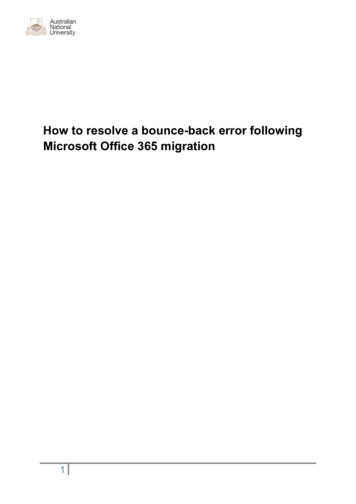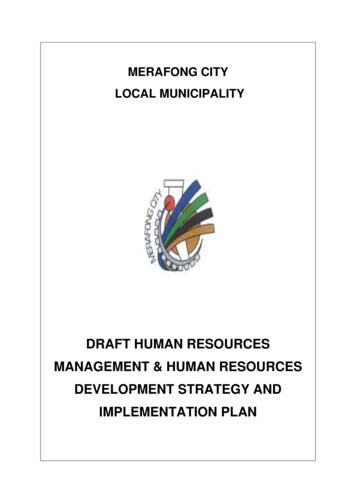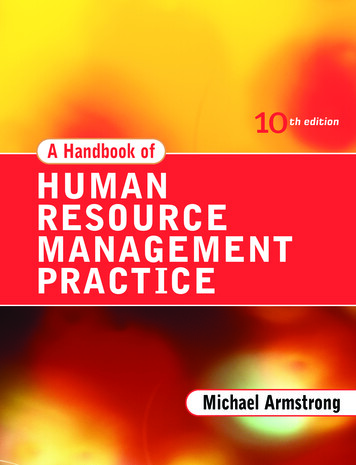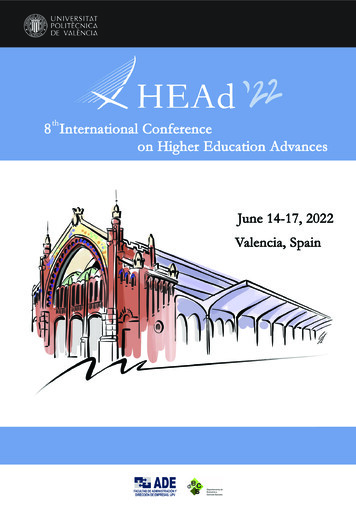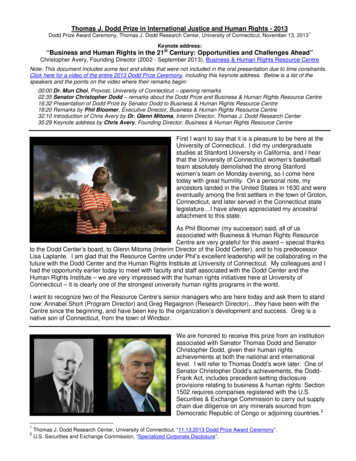
Transcription
Thomas J. Dodd Prize in International Justice and Human Rights - 2013Dodd Prize Award Ceremony, Thomas J. Dodd Research Center, University of Connecticut, November 13, 20131Keynote address:“Business and Human Rights in the 21st Century: Opportunities and Challenges Ahead”Christopher Avery, Founding Director (2002 - September 2013), Business & Human Rights Resource CentreNote: This document includes some text and slides that were not included in the oral presentation due to time constraints.Click here for a video of the entire 2013 Dodd Prize Ceremony, including this keynote address. Below is a list of thespeakers and the points on the video where their remarks begin:00:00 Dr. Mun Choi, Provost, University of Connecticut – opening remarks02:35 Senator Christopher Dodd – remarks about the Dodd Prize and Business & Human Rights Resource Centre16:32 Presentation of Dodd Prize by Senator Dodd to Business & Human Rights Resource Centre18:20 Remarks by Phil Bloomer, Executive Director, Business & Human Rights Resource Centre32:10 Introduction of Chris Avery by Dr. Glenn Mitoma, Interim Director, Thomas J. Dodd Research Center35:29 Keynote address by Chris Avery, Founding Director, Business & Human Rights Resource CentreFirst I want to say that it is a pleasure to be here at theUniversity of Connecticut. I did my undergraduatestudies at Stanford University in California, and I hearthat the University of Connecticut women’s basketballteam absolutely demolished the strong Stanfordwomen’s team on Monday evening, so I come heretoday with great humility. On a personal note, myancestors landed in the United States in 1630 and wereeventually among the first settlers in the town of Groton,Connecticut, and later served in the Connecticut statelegislature I have always appreciated my ancestralattachment to this state.As Phil Bloomer (my successor) said, all of usassociated with Business & Human Rights ResourceCentre are very grateful for this award – special thanksto the Dodd Center’s board, to Glenn Mitoma (Interim Director of the Dodd Center), and to his predecessorLisa Laplante. I am glad that the Resource Centre under Phil’s excellent leadership will be collaborating in thefuture with the Dodd Center and the Human Rights Institute at University of Connecticut. My colleagues and Ihad the opportunity earlier today to meet with faculty and staff associated with the Dodd Center and theHuman Rights Institute – we are very impressed with the human rights initiatives here at University ofConnecticut – it is clearly one of the strongest university human rights programs in the world.I want to recognize two of the Resource Centre’s senior managers who are here today and ask them to standnow: Annabel Short (Program Director) and Greg Regaignon (Research Director) they have been with theCentre since the beginning, and have been key to the organization’s development and success. Greg is anative son of Connecticut, from the town of Windsor.We are honored to receive this prize from an institutionassociated with Senator Thomas Dodd and SenatorChristopher Dodd, given their human rightsachievements at both the national and internationallevel. I will refer to Thomas Dodd’s work later. One ofSenator Christopher Dodd’s achievements, the DoddFrank Act, includes precedent-setting disclosureprovisions relating to business & human rights: Section1502 requires companies registered with the U.S.Securities & Exchange Commission to carry out supplychain due diligence on any minerals sourced fromDemocratic Republic of Congo or adjoining countries. 212Thomas J. Dodd Research Center, University of Connecticut, “11.13.2013 Dodd Prize Award Ceremony”.U.S. Securities and Exchange Commission, “Specialized Corporate Disclosure”.
2Section 1504 requires companies to publicly report how much they pay governments for access to oil, gas andminerals. 3 As Phil mentioned, in 2012 the Resource Centre sought and secured responses from companiesand business associations when concerns were raised about industry efforts to undermine implementation ofDodd-Frank section 1502. Some companies responded that they supported the Dodd-Frank provision and didnot agree with the lobbying by their industry association against the law. 4I realize that the Dodd family has Irish ancestry, but even if that were not the case I would want to mention anindividual without whom the Resource Centre might never have gotten off the ground Mary Robinson, former President of Ireland and UnitedNations High Commissioner for Human Rights, now UNSpecial Envoy for the Great Lakes region of Africa, haschaired the Resource Centre’s International AdvisoryNetwork from the beginning. She has been a source ofgreat inspiration and encouragement.My remarks will cover three topics:1. Some important moments in the history ofbusiness & human rights.2. Some personal reflections on progress madeover the past 11 years, since the Resource Centre wasfounded.3. Challenges and opportunities for the future.1. Some important moments in historyThe Greek philosopher Aristotle said: “If you wouldunderstand anything, observe its beginning and itsdevelopment.”Many think of business & human rights as a relativelynew field. But the link between business and humanrights goes far back.In his 2012 book The International Human RightsMovement: A History 5, Aryeh Neier (President Emeritusof Open Society Foundations, former Executive Directorof Human Rights Watch) traces the origins of the humanrights movement to the first time that a large group ofpeople advocated for the rights of others, rather than fortheir own rights – the movement to abolish slavery.As you know, business and slavery were closelyinterlinked slavery powered the supply chains ofcotton, sugar, rice, tobacco and other commodities thatenriched North American and European companies. Sofrom the very beginning of the international human rightsmovement, business has been an important part of thelandscape.3U.S. Securities and Exchange Commission, “Specialized Corporate Disclosure”.Business & Human Rights Resource Centre, “Lobbying ‘seeking to undermine’ Dodd-Frank conflict minerals legislation responses & non-responses by companies & business orgs.”.5Aryeh Neier, The International Human Rights Movement: A History, 2012 (Princeton University Press).4
3Some of you in this room will know that in 2005 severaljournalists from the Hartford Courant newspaper wrotean excellent book entitled: Complicity: How the NorthPromoted, Prolonged and Profited from Slavery. 6 Theirbook, and the Hartford Courant articles on the subjectthat preceded the book 7, document the close connectionbetween slavery and manufacturing, finance andinsurance companies in New York and New England.When it appeared that the South might secede, many ofthese Northern businesspeople, fearing they would losethe economic benefits of slavery, publicly expressedsympathy with the South and condemned Northernabolitionists.The connection between U.S. companies and slaverycontinued long after abolition in the U.S. For example two of the world’s leading ivory companies, based inConnecticut, transformed ivory into piano keys andbilliard balls. The book by the Hartford Courantjournalists describes the supply chain 8: The ivory camefrom North African slave traders who rounded up andenslaved black Africans in Africa. It was a particularlybrutal system that slaughtered huge numbers of peopleas well as elephants. African villages were burned bythe traders and their armed mercenaries.Slaves were forced to carry heavy tusks up to 1000miles to the African coast, connected by chains as theywalked, 40 or 50 chained together.6Anne Farrow, Joel Lang and Jenifer Frank, Complicity: How the North Promoted, Prolonged, and Profited from Slavery, 2005(Ballantine Books).7“Special Report - Complicity: How Connecticut Chained Itself To Slavery”, Hartford Courant, 29 Sep 2002.8Farrow, Lang and Frank, Chapter 10: “Plunder for pianos”, in Complicity: How the North Promoted, Prolonged, and Profitedfrom Slavery.
4Iron rings were put around their necks. Many werewhipped. Many died on the way of disease orstarvation. One Massachusetts ivory trader saw shipsfull of these slaves coming to Zanzibar from mainlandAfrica .he wrote that dead slaves were simply thrownoverboard and if they floated onto shore the locals camewith poles to push the bodies off the beach back to sea.Historians estimate that 5 black Africans were killed orforced into slavery for each elephant tusk that reachedthe coast of Africa. That would mean 2 million blackAfricans were killed or forced into slavery to supply theivory sent to the Connecticut ivory factories between1870 and 1900, to make piano keys and billiard balls. 9It was a lucrative system.The owners of these Connecticut ivory companies hadwhat one historian called “bifurcated minds” – they couldbe abolitionists and philanthropists in their personallives, but their priority was running profitable ivorycompanies, so they externalized or ignored what washappening in their supply chain. 10Today we see more and more business people starting to take human rights more seriously. But we still seesome businesspeople in every country with “bifurcated minds”, failing to effectively address human rightsabuses, including in their supply chains. The victims of these abuses today include 9Anne Farrow, “Chapter Seven: The Last Slaves - Not Just Elephants Suffered And Died For Connecticut's Ivory” in “SpecialReport - Complicity: How Connecticut Chained Itself To Slavery”, Hartford Courant, 29 Sep 2002.10Farrow, Lang and Frank, Chapter 10: “Plunder for pianos”, in Complicity: How the North Promoted, Prolonged, and Profitedfrom Slavery.
5 apparel workers in Bangladesh killed and injured inunsafe factories; indigenous communities in Latin America displacedby mining companies and agribusiness; men, women and particularly children in countriessuch as China and India whose health is permanentlydamaged by the toxic emissions of chemical andindustrial factories; and men, women and children in Democratic Republic ofCongo who suffer at the hands of armed groups lootingthe country of “conflict minerals” which are then used incell phones and laptops.
6The final historical period I want to mention is World WarII and the Holocaust. When Thomas Dodd wasprosecuting Nazi war criminals at the Nuremberg trials,he showed through his evidence that Hitler’s UkrainianOverlord Erich Koch and Polish Overlord Hans Frankwere responsible for the plan to deport 1 million Polishcivilians to work as slave laborers in Germany, many inthe factories of private German companies. 11 UnderErich Koch’s rule, some 2.5 million Ukrainians werereportedly deported to the German Reich to work asslave laborers.12Thomas Dodd also showed that defendant Walther Funkturned the Reichsbank, then Germany’s privately ownedcentral bank, into a depository for gold teeth and othervaluables seized from concentration camp victims. 13So among his many achievements at Nuremberg,Thomas Dodd was seeking and securing accountabilityfor those engaged in human rights abuses whichinvolved business.After the main trials at Nuremberg, other trials were heldbefore American military tribunals – including trials ofGerman business leaders for assisting Nazi war crimes.A key corporate defendant was Alfried Krupp, chargedwith crimes against humanity by participating in themurder, extermination, enslavement, deportation, imprisonment, torture, and use for slave labor of civilians whocame under German control. He pleaded “not guilty”,arguing what many businesspeople in many countrieshave argued since then when their companies werealleged to be involved in human rights abuses – he said:"We Krupps never cared much about [political]ideas. We only wanted a system that workedwell and allowed us to work unhindered. Politicsis not our business."1411"Ukraine Murder Chief Still Hunted by Allies", Los Angeles Times, 12 Dec 1945, p. 4, cited in Wikipedia entry: “Thomas J.Dodd”.12“Erich Koch”, Ukrainian Canadian Research & Documentation Centre; Andrew Gregorovich, “World War II in Ukraine: Kochversus Rosenberg”, FORUM: A Ukrainian Review, No. 92, Spring 1995.13Wikipedia entry: “Thomas J. Dodd”.14Wikipedia entry: “Krupp Trial”.
72. My reflections on progress madeover the past 11 years, since the founding ofBusiness & Human Rights Resource CentreFast-forward to 2002. We started Business & HumanRights Resource Centre because it was very difficult tofind hard information at that time about the human rightsimpacts of companies on the ground where they wereoperating around the world. There was a lot of talkabout corporate social responsibility at the time, butmuch of it was fuzzy and superficial, focused more onheadquarters policy than operational realities. Forexample, company conduct toward women was rated bycounting the number of women on the board, rather thanlooking at how that company and its suppliers weretreating female employees worldwide and impactingwomen in local communities.We wanted to use the power of the internet to injectreality, to provide more transparency and public accountability, and to collect tools and examples of goodpractice to help all those working in this field.There are 4 fundamental aspects of the Resource Centre’s model which have served us well:1. The Centre has a strict policy against accepting any donations from companies or companyfoundations, to ensure the organization’s independence and to prevent any perception of a potentialconflict of interest.2. The Centre covers both positive and negative impacts of companies, is committed to being fair in itsapproach, and posts information from all sources, including from advocates and from companies.3. The Centre gives companies an opportunity to respond to allegations, and gives advocates theopportunity to comment on the company’s response.4. The Centre’s researchers are based throughout the world, since there is no substitute for speakinglocal languages and having face-to-face contact with victims, advocates and businesspeople.Looking back over the past 11 years, what stands out tome? I have been struck by how the burden has shifted.When we started the Resource Centre, we had troublegetting businesspeople to even understand theconnection between business and human rights. Thingshave changed. Now the burden is on businesses to demonstrate that they are respecting human rights.
8Why has the burden shifted?In large part because of the United Nations GuidingPrinciples on Business and Human Rights, 15 the first UNstandard broadly covering this subject. The fact that theprinciples were endorsed by consensus by the UNHuman Rights Council in 2011 was a great achievementby John Ruggie (the UN Special Representative onbusiness & human rights who drafted the principles) andhis team. The consensus endorsement makes it difficultfor any company or government to question the authorityof the Principles.Each Guiding Principle is accompanied by acommentary.For anyone wanting an in-depth understanding of theGuiding Principles, I would recommend John Ruggie’sbook Just Business: Multinational Corporations andHuman Rights. 16I would also recommend a commentary by Chris AlbinLackey of Human Rights Watch on his view of theshortcomings of the Guiding Principles – entitled“Without Rules: A Failed Approach to CorporateAccountability”. 1715Text of the UN Guiding Principles.John Ruggie, Just Business: Multinational Corporations and Human Rights, 2013 (W. W. Norton & Company).17Christopher Albin-Lackey, Senior Researcher - Business and Human Rights, Human Rights Watch, “Without Rules: A FailedApproach to Corporate Accountability”, in Human Rights Watch - World Report 2013, 31 Jan 2013.16
9I would further recommend Ruggie’s response to AlbinLackey’s critique – entitled “Progress in CorporateAccountability”. 18John Ruggie and Chris Albin-Lackey do agree that theUN Guiding Principles are a beginning, not the end.International standards are not very useful unless civilsociety is monitoring the conduct of companies andgovernments and seeking accountability. One of themost promising developments over the past 11 years isthat national and local human rights, environmental anddevelopment organizations – and community andindigenous groups – across the world have beenturning more of their attention to the private sector. Themost important human rights work is being done at thelocal level, by advocates who sometimes risk their livesor freedom to seek justice.I have been pleased to see that most companies haveresponded to the Resource Centre when we invitedthem to comment on concerns raised about theirconduct. I expected a 20% or 30% response rate, but ithas been 70%.over 90% from South Africancompanies, and around 50% from mainland Chinesecompanies which is encouraging because some ofthese Chinese firms had never before been approachedby or responded to an independent organization abouthuman rights concerns.This slide shows an example of a response we receivedfrom a mainland Chinese company – in this case weinvited Chinese timber firm Baishanlin to respond toallegations of human rights abuses at its operations inGuyana. It sent us a relatively detailed response sayingthat it would endeavor to address various concerns.1918Professor John Ruggie, “Progress in Corporate Accountability”, on Institute for Human Rights and Business website, 4 Feb2013.19Baishanlin Intl. Forest Development, “Baishanlin Intl. Forest Development response regarding labour rights abuses atCoomacka timber works, Guyana”, 28 Aug 2007.
10We were pleased to see a few weeks later a leadingGuyanese newspaper report that the Minister of Laborof Guyana had re-inspected the Baishanlin (also spelledBai Shan Lin) operations and noted improvements inworking conditions.20Another example: In 2006, when we sought responsesfrom diamond mining companies operating in Angolabecause their security firms were reportedly committingshocking human rights abuses against local civiliansincluding torture, sexual abuse and in some caseskillings we secured responses from all five diamondcompanies, which helped stir up a debate on theseissues in Angola. 21 And we heard from the investigativejournalist who reported the abuses that for the first timehe was invited to discuss his concerns with seniormanagers at some of the companies.I was pleasantly surprised last December to see over1000 people attending the first United Nations Forum onBusiness and Human Rights in Geneva 22. The UN wasalso caught by surprise; they didn’t expect such a levelof interest, and at the last minute had to switch theopening plenary session into the old League of NationsAssembly Hall built in 1937, which is seldom used butwas the only place big enough to hold the crowd.20“Nadir promises more vigilance on workers’ rights, safety”, Stabroek News, 28 Aug 2007, p. 26.Business & Human Rights Resource Centre, “Responses by diamond companies to report on abuses related to diamondmining in Cuango, Angola, 2006.22Business & Human Rights Resource Centre website section: “UN Forum on Business and Human Rights”.21
11A particularly powerful presentation at the Forum’sopening plenary was by Malaysian human rights activistDebbie Stothard. She listed the names of men, womenand children across the world who had recently beenkilled or imprisoned for their work to stop human rightsabuses by business. I encourage you to watch the videoof her presentation on YouTube. 23I have been glad to see the United Nations WorkingGroup on Human Rights make useful country visits – sofar to Mongolia, Ghana and the United States. 24I was impressed by what John Ruggie said at the recentUN Global Compact Leaders Summit, when he called onbusiness to address global issues including human rightswith more urgency and will: “One critical gap lies in therealm of global governance itself: the growing misalignment between the scope and impact of globalizing forcesand actors, and the capacity of societies to manage theiradverse consequences International business isuniquely positioned to help bridge this gap: it has globalinterests, and it has global capacity. And yet when the business community at large speaks in bridging terms,typically it is barely above a whisper; and when it acts, it is with a pilot project here, or a strategic communityinvestment there. This lies in sharp contrast to when an individual firm or industry seeks particular advantagesand protections for itself: then the message is loud and clear, and the actions are systemic.” 25I have been impressed with human rights guidancematerials for business developed by the Office of theUnited Nations High Commissioner for Human Rights 26,UN Global Compact 27, and other organizations includingthe Institute for Human Rights and Business 28, Shift29,Danish Institute for Human Rights 30, Conectas 31,SOMO 32, Global Business Initiative on Human Rights 33,BSR (Business for Social Responsibility) 34 andtwentyfifty 35. These and other materials are accessiblevia the Resource Centre’s “Tools & Guidance Portal” 36.23Keynote statement by Debbie Stothard, Deputy Secretary-General of FIDH and Coordinator of ALTSEAN-Burma, at theOpening Session of the 1st UN Forum on Business & Human Rights, 4 Dec 2012, Geneva.24Business & Human Rights Resource Centre website section: “UN Working Group on business & human rights – Countryvisits”.25John G. Ruggie, Harvard University, Former UN Special Representative on business & human rights, “Remarks at OpeningPlenary”, UN Global Compact Leaders Summit 2013, New York, 20 Sep 2013.26Office of the United Nations High Commissioner for Human Rights website.27UN Global Compact website.28Institute for Human Rights and Business website.29Shift website.30Danish Institute for Human Rights website.31Conectas website.32SOMO website.33Global Business Initiative on Human Rights website.34BSR (Business for Social Responsibility) website.35twentyfifty website.36Business & Human Rights Resource Centre, “Tools & Guidance Portal”.
12Some governments – including Norway 37, UnitedKingdom 38 and United States 39 – have publishedimportant reports on how they are undertaking their dutyto ensure respect for human rights by business. Mycolleagues and I were very pleased to see that the UKGovernment issued its report not only in English but alsoin Arabic, Chinese, French, Lithuanian, Portuguese,Russian and Spanish. 40 Other European governmentsare expected to publish similar reports 41; theGovernment of Spain has released a draft NationalAction Plan 42. There are initiatives inside Colombia 43that may lead to that government doing the same.Another promising development: an increasing numberof multi-stakeholder initiatives involving companies, civilsociety and often governments as well. These include: Extractive Industries Transparency Initiative 44 Fair Labor Association 45 Global Network Initiative 46 International Code of Conduct for PrivateSecurity Service Providers 47 Kimberley Process Certification Scheme 48 Voluntary Principles on Security and HumanRights 49Some of these initiatives are more effective than others– the more effective initiatives are those with strong civilsociety participation and with strong accountabilitymechanisms requiring corporate members to undertakecertain steps in order to retain their membership.37Norwegian Ministry of Foreign Affairs, “Corporate social responsibility in a global economy”, 23 Jan 2009.Foreign & Commonwealth Office, United Kingdom, “UK first to launch action plan on business and human rights”, 4 Sep 2013.39U.S. Department of State - Bureau of Democracy, Human Rights & Labor, “U.S. Government Approach on Business andHuman Rights”, 1 May 2013.40Foreign & Commonwealth Office, United Kingdom, “Good Business: Implementing the UN Guiding Principles on Business andHuman Rights”, 4 Sep 2013.41International Corporate Accountability Roundtable (ICAR) and the Danish Institute for Human Rights (DIHR), “Interim Briefing:National Actions Plans (NAPs) on Business and Human Rights”, 2 Dec 2013.42Gobierno de España, “Plan de Empresa y Derechos Humanos”, 25 noviembre 2013; Gobierno de España, “Hoja de ruta sobrela elaboración del plan nacional empresas y derechos humanos”, 12 noviembre 2013.43Sustentia and DIS Foundation, “Cuaderno-Guia of The UN Guiding Principles on Business and Human Rights: Gateway”, 1Nov 2013; in Spanish: Sustentia y Fundación DIS, “Cuaderno-guía de los principios rectores ONU sobre empresa y DDHH:Puerta de entrada”, 1 noviembre 2013.44Extractive Industries Transparency Initiative website.45Fair Labor Association website.46Global Network Initiative website.47International Code of Conduct for Private Security Service Providers website.48Kimberley Process Certification Scheme website.49Voluntary Principles on Security and Human Rights website.38
13I have been impressed when companies undertakesubstantive positive initiatives, for example: Phil already mentioned that adidas 50, AngloAmerican 51, Microsoft 52 and Rio Tinto 53 issued publicreports on how they are implementing the UN GuidingPrinciples I hope more companies will do the same. General Electric, a company headquartered herein Connecticut, has been at the center of business &human rights initiatives by companies – first as amember of the pioneering Business Leaders Initiative onHuman Rights 54, chaired by Mary Robinson, and now asa member of the Global Business Initiative on HumanRights 55. An example of a GE initiative: As part of GE’s supply-chain due-diligence program it has been takingsteps to avoid the use of conflict minerals, and the GE Foundation has been working directly on the groundwith NGOs in the Democratic Republic of Congo that are endeavoring to stop human rights abuses.56Another positive initiative by a company: I was told by amanager of a large multinational firm that when the firmwas considering whether or not to purchase anothermultinational company, it first researched the humanrights record of that firm on our website. But it wenteven further in its due diligence – it also examined onour website the human rights record of each of thatcompany’s 40 largest customer companies, given that itwould acquire those customer contracts.But I have been frustrated to see the slow pace ofprogress, and frustrated when companies andgovernments fail to live up to their responsibilities.Let me illustrate this with one case. This case startswith an impressive Pakistan-based NGO called BoloBhi 57 (which translates “Speak Out”); Sana Saleem isits director. When the Pakistan Government issued apublic tender for development and deployment of a URLfiltering and blocking system in February 2012, Bolo Bhiissued a petition calling on 8 tech companies not torespond to the tender because it would lead to acensorship regime. Bolo Bhi asked if we could help: we approached senior people at the relevant companies,inviting them to respond to the concerns raised in Bolo Bhi’s petition. 5850adidas Group, “Human Rights and Responsible Business Practices: Frequently Asked Questions”, Jul 2011.Jan Klawitter (Anglo American) & Luke Wilde (twentyfifty), “Jan Klawitter: Implementing the UN Guiding Principles on businessand human rights – the experience of Anglo American”, on Business Fights Poverty blog, 28 Jun 2013.52Dan Bross, Senior Director, Microsoft Corporate Citizenship, “How Microsoft Did It: Implementing the Guiding Principles onBusiness and Human Rights”, 4 Dec 2012.53Rio Tinto, in partnership with Centre for Social Responsibility in Mining (CSRM), Sustainable Minerals Institute at TheUniversity of Queensland, “Why human rights matter: a resource guide for integrating human rights into Communities and SocialPerformance work at Rio Tinto”, Jan 2013.54Business Leaders Initiative on Human Rights, “Policy Report 4”, 2009.55Global Business Initiative on Human Rights website.56General Electric, “GE Publishes Response to Conflict Minerals”, 13 Jun 2013, on CSRwire website.57Bolo Bhi website.58Business & Human Rights Resource Centre special page: “Pakistan Govt tender for an internet filtering and blocking system”.51
14A few days later web filtering software firm Websensecommitted not to apply for the tender and called onother firms to follow suit. With further follow-up, weobtained commitments from Cisco, Sandvine andVerizon not to bid. 59 Later McAfee announced that itwould not bid.In March 2012 it was reported that the PakistanGovernment had indicated it was withdrawing its planfor the internet filtering system.60 Unfortunately, that isnot the end of the story.In June 2013 The Citizen Lab at University of Torontoreported that technology developed by Canadiancompany Netsweeper was “being implemented inPakistan for the purposes of political and socialfiltering.” 61 Netsweeper had failed to respond the yearbefore when we invited responses to Bolo Bhi’s petition.We invited a response from Netsweeper to these newallegations. Again the company refused to respond tous and to others.62We then wrote to the Canadian Ministry of ForeignAffairs, Trade and Development, inviting their commentson any steps the Canadian Government was taking tourge Netsweeper to respond publicly. 63 The Ministryreplied to us: “With respect to the Canadian companyNetsweeper, while we cannot speak about the affairs of any one firm due to privacy constraints, we doroutinely encourage Canadian company clients to behave responsibly and in accordance with internationalbest practices regarding respect for human rights, including freedom of expression.” 6459Business & Human Rights Resource Centre special page: “Pakistan Govt tender for an internet filtering and blocking system”.Neal Ungerleider, “Pakistan Torches National Firewall Plans”, Fast Company, 20 Mar 2012.61The Citizen Lab, “O Pakistan, We Stand on Guard for Thee: An Analysis of Canada-based Netsweeper’s Role in Pakistan’sCensorship Regime”, 20 Jun 2013.62Business & Human Rights Resource Cen
Dodd Prize Award Ceremony, Thomas J. Dodd Research Center, University of Connecticut, November 13, 2013 . "Business and Human Rights in the 21. st. Century: Opportunities and Challenges Ahead" Christopher Avery, Founding Director (2002 - September 2013), . Human Rights Institute - we are very impressed with the human rights .


